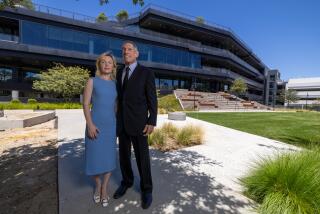Sale to Boost Hughes Medical Institute Funds : $5-Billion Endowment to Make It Richest in U.S.
- Share via
The Howard Hughes Medical Institute, nearly as reclusive as its billionaire founder was in his final years, is about to become to medical research what the J. Paul Getty Museum is to the world art community as a result of the planned sale of Hughes Aircraft to General Motors.
The institute, which now operates on dividends from Hughes Aircraft, is expected to realize about $5 billion from the sale--giving it an endowment that will exceed that of the nation’s current largest charitable body, the Ford Foundation. The Ford Foundation’s endowment is about $3.6 billion.
For the record:
12:00 a.m. June 7, 1985 FOR THE RECORD
Los Angeles Times Friday June 7, 1985 Home Edition Business Part 4 Page 2 Column 4 Financial Desk 1 inches; 34 words Type of Material: Correction
The National Institutes of Health are located in Bethesda, Md. Due to an editing error, The Times incorrectly reported the location of the National Institutes’ headquarters in a Thursday article about the Howard Hughes Medical Institute.
The institute’s new-found prosperity has not been lost on officials at the nation’s 140 medical schools, who are already formulating plans to apply for research funding from it.
“Like other schools, we’ve been in touch with them and are hoping for the best,” said John Crowe, executive director of development for the University of Southern California medical school. “But the big question is whether they are going to change their method of giving.”
Added William J. Harrington, a professor at the University of Miami medical school, which received more than $10 million from the institute during the 1970s: “They are fairly independent in the way they give money.” You don’t contact them, Harrington said, “they’ll contact you if they want to fund a program.”
Housed in nondescript offices across the street from the University of Miami, the institute was created in 1953 as a public-relations ploy by Howard R. Hughes, a man who hated physicians. The institute spent about $85 million last year to fund 200 scientists overseeing 17 research projects in California, Utah, Washington and 11 other states.
For example, the institute announced Wednesday a $12-million grant to the University of California, San Diego medical school and the Salk Institute that will establish a genetic research center on the La Jolla campus.
Such spending will grow as a result of the sale of Hughes Aircraft. Donald S. Fredrickson, president of the institute, said Wednesday that he expects the institute to have about $200 million--or 5% of its endowment--available for research annually.
“We will not change our programmatic approach,” said Fredrickson, who added that the institute generally favors giving $5 million to $7 million or more for long-term research projects. He said, however, that the institute’s trustees “have been deeply involved” in formulating new guidelines for awarding research money.
Fredrickson added that the institute will probably add to its staff of 50 in order to be able to evaluate more research projects.
The institute’s board, which was recently expanded to a nine-member blue ribbon group that includes Irving Shapiro, the former Du Pont chairman, has undertaken “blue sky” studies of how to spend this money, according to Fredrickson, a former president of the U.S. government’s Atlanta-based National Institutes of Health.
Howard Hughes created the institute in 1953 as a public relations ploy after four of his top executives, denied stock options and other management perks, quit his pioneering electronics company, according to investigative reporter and author James Phelan, one of Hughes’ biographers.
Two of the Hughes executives who quit--Simon Ramo and Dean Wooldridge--formed their own firm, which became TRW. Another Hughes executive, Tex Thornton, left to form Litton Industries.
Ramo has said that one of his last acts before leaving Hughes’ employ was to recommend giving the firm’s stock to a charity. Hughes did but made himself its sole trustee.
Howard Hughes financed his reclusive life style in part with huge loans, the interest on which was paid by the Hughes institute. Paying the interest on these debts consumed more than 40% of the money that Hughes Aircraft paid in dividends to the Hughes Institute in the 1960s and 1970s. The institute spent nearly equal amounts on the loan payments and medical research, with the rest being consumed by lavish salaries for institute executives and others.
Little is known about how the institute determines the projects that it wants to fund. But in those projects that it has funded in the past, it has maintained considerable control.
Unlike other major medical research funding groups, such as the National Institutes of Health, the Hughes institute usually outlines the research that it wants studied, builds the lab and hires the scientists, who are then given university appointments.
Yet, even under the best of conditions, it will take years for the results of the institute’s new-found funds to result in scientific breakthroughs that might affect patients, experts say. In the past, the institute has chosen to concentrate on funding so-called basic research in genetics, immunology, metabolism and neuroscience rather than on finding cures for diseases.
Times staff writer David Johnston contributed to this story.
More to Read
Sign up for Essential California
The most important California stories and recommendations in your inbox every morning.
You may occasionally receive promotional content from the Los Angeles Times.













